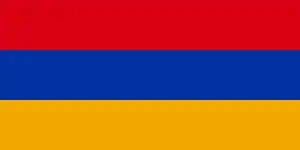| Blue Mosque | |
|---|---|
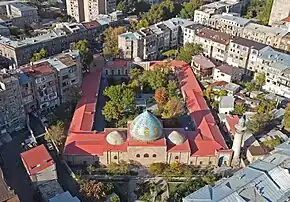 An aerial view of the mosque | |
| Religion | |
| Affiliation | Islam |
| Rite | Twelver Shia |
| Ecclesiastical or organizational status | Mosque |
| Location | |
| Location | 12 Mashtots Avenue, Yerevan, Armenia[1][2] |
| Geographic coordinates | 40°10′41″N 44°30′20″E / 40.1781°N 44.5056°E |
| Architecture | |
| Style | Iranian |
| Completed | 1765–1766 |
| Specifications | |
| Dome(s) | 1 |
| Minaret(s) | 1 |
| Minaret height | 24 metres (79 ft)[3][4] |
The Blue Mosque is an 18th-century Shia mosque in Yerevan, Armenia. It was commissioned by Hoseyn Ali Khan, the khan of the Iranian Erivan Khanate. It is one of the oldest extant structures in central Yerevan and the most significant structure from the city's Iranian period. It was the largest of the eight mosques of Yerevan in the 19th century and is the only active mosque in Armenia today.
The mosque was secularized in the 1920s and housed the History Museum of Yerevan for more than five decades. Following Armenia's independence, the mosque was renovated with support from the Iranian government and again started operating as a mosque, serving the Muslims residing in Armenia.
Names
Western visitors in the Russian period, such as H. F. B. Lynch and Luigi Villari, referred to the mosque as Gök Jami (Gok Djami),[5][6][3][7] which translates from Turkish as 'sky blue mosque'.[8] It is known as Kapuyt mzkit’ 'Blue Mosque' in Armenian, although Gyoy mzkit’ is sometimes used as well.[1] It is known in Persian as Masjid-i Juma 'Friday mosque' or Jami-i Shahr 'city congregational mosque'.[7][3]
History
.jpg.webp)
.jpg.webp)
Early history
The mosque was built in 1765–1766 (AH 1179)[lower-alpha 1] by Hoseyn Ali Khan, the ruler of the Erivan Khanate under the Afsharid dynasty[3][1] as the city's main Friday mosque.[8] The mosque was the largest of the eight mosques operating in Yerevan when the Russians captured it in 1827.[8][5][8] The mosque underwent substantial redecoration with tiles around 1887-88 (AH 1305), under Russian administration.[7] The mosque underwent another reconstruction in 1907–1910.[9]
H. F. B. Lynch, who visited Erivan in 1890s, wrote: "There is nothing very remarkable in the architecture of the mosque; but the floral paintings which adorn the ceiling of a companion and smaller edifice on the north side of the court are of very high merit."[10] Luigi Villari, an Italian diplomat and historian, gave a detailed description of the mosque in his 1906 book titled Fire and Sword in the Caucasus. He wrote that the "great mosque called the Gok Djami [...] is a good deal more than a mosque; it is a long quadrangle containing several places of worship and a number of cells, schools, and offices of the Moslem religious administration. It is not very ancient [...] but it is handsome."[6] The Encyclopædia Britannica (1911) described the mosque as the "finest building in the city."[11] The minaret of the mosque, standing at 24 metres (79 ft) was the tallest structure in 19th century Yerevan.[12]
Soviet period
The mosque was secularized after Soviet rule was established in Armenia. The mosque's entrances and exits were modified significantly. The main gate, on the southern side, to the right of the minaret was blocked. The western gate was "incorporated into a residence complex and became hardly recognizable as an entrance." The entrance on the northern side became the only entrance. It is accessible and visible from Mashtots Avenue.[12] Beginning with Alexander Tamanian's 1924 master plan for Yerevan, the mosque has been situated more than two meters below the street level, which requires visitors to descend a flight of steps.[13]
The mosque ceased to operate as a religious institution in the mid-1920s. Its courtyard became a "creative space for Armenian artists, writers, poets, and intelligentsia, facilitating the production of a new cultural and aesthetic order for socialist Armenia. The courtyard was protected by large elm and plane trees, and in this way provided the hot and dusty city with a shaded refuge."[12] The courtyard housed a teahouse, which became a hub for intellectual gatherings. Yeghishe Charents, Martiros Saryan, Aksel Bakunts were among its regular visitors. Foreign guests included Armenian-American writer William Saroyan, Russian poet Osip Mandelstam, Russian novelist Andrei Bely and others. Local artists used the "courtyard for exhibitions and as a laboratory for new socialist spirituality."[14] Seyed Hossein Tabatabai, Adviser of the Cultural Center of the Iranian Embassy in Armenia, noted that the mosque was "preserved by the efforts of a number of Armenian intellectuals," especially Charents.[15]
In the 1930s, first the Anti-Religious Museum and subsequently the Museum of Antifascism were housed at the mosque. From 1936 until the collapse of the Soviet Union, the mosque housed the Museum of Natural Sciences, which included a planetarium inside the main prayer hall and the Yerevan History Museum.[13][16]
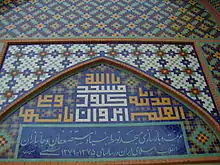
Independence period
In the late 1980s, during the Nagorno-Karabakh conflict, the mosque did not sustain any damages because it was considered to be Persian, not Azerbaijani, and housed the city's history museum.[13]
In February 1991, a preliminary agreement was reached between the city's authorities and an Iranian delegation to restore the mosque.[17] The mosque underwent major renovation between 1994 and 1998.[1] The city's authorities officially transferred the right to use the mosque to Iran on October 13, 1995.[18] The government of Iran allocated some 1 billion Iranian rials (over $1 million) for restoration works.[19][20] The mosque was re-opened as a religious institution in 1996.[13] Brady Kiesling described the restoration as "structurally necessary but aesthetically ambiguous."[8]
Another reconstruction was done between 2009 and 2011.[9]
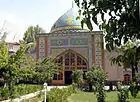
Today
The Blue Mosque is the only active mosque in Armenia,[21][22] which has a small Muslim population (between 812[23] and 1,000 or 0.03% of the total population).[24]
Since restoration, it has become a religious and cultural center for the Iranians residing in Armenia and Iranian tourists visiting Armenia.[21] In 2003 the journalist Thomas de Waal noted that the only regular worshippers at the mosque were "the dozen or so diplomats from the Iranian Embassy."[25] Less than a decade later, in 2009, ArmeniaNow wrote that of the up to 2,000 Iranians residing in Yerevan as many as 500 periodically attend the mosque on Thursdays.[26] The Iranian cultural center inside the mosque complex attracts young Armenians seeking to learn Persian.[27] The Persian library of over 8,000 items, named after the poet Hafez, was opened inside the complex in October 2014.[28]
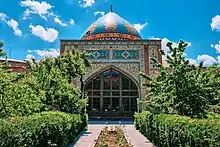
On December 10, 2015, the government of Armenia leased the mosque complex to the embassy of Iran to Armenia for 99 years to use it as a cultural center.[29][30]
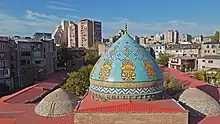
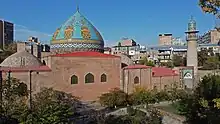
.jpg.webp)
Architecture
The mosque is listed by the Armenian government as a monument of national significance.[1] It is "one of the oldest buildings in central Yerevan"[3] and the "only extant building of the Iranian period in Yerevan."[7] The historian of Islamic art Markus Ritter described it as the "main model for the early Qajar mosque architecture of the Iranian period."[12] The mosque complex covers an area of 7,000 square metres (75,000 sq ft).[4] The mosque itself is 97 by 66 metres (318 ft × 217 ft),[9] while the courtyard is 70 by 47 metres (230 ft × 154 ft).[7] The mosque contains the traditional Shia attributes, including a minaret, three mihrabs (prayer halls), holy inscriptions, etc.[31] The mosque includes 24 arched cells that face the pool in the middle of the courtyard, which is surrounded by a rose garden.[3] The minaret, standing at 24 metres (79 ft) tall,[4][3] has a 7-degree slope, but is considered to be architecturally safe.[9]
Efforts to list as a World Heritage Site
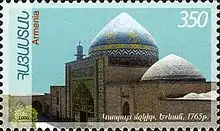
In October 2007 Armenian Foreign Affairs Minister Vartan Oskanian stated during his speech at the 34th session of the UNESCO General Conference in Paris that the Blue Mosque and other sites are on the waiting list for inclusion in the UNESCO World Heritage List.[32] In January 2013 Armenian Minister of Culture Hasmik Poghosyan stated that Armenia will take all possible steps for inclusion of the mosque in the list.[33][34] She reaffirmed this position in a meeting with Iranian Culture Minister Mohammad Hosseini in April 2013. Hosseini stated that he hoped Armenian efforts would succeed.[35] Armenia's Foreign Affairs Minister Eduard Nalbandyan, in his speech at the 38th session of UNESCO General Conference in November 2015:[36]
...neighboring Iran has made great efforts to preserve and protect the Armenian cultural heritage. The Armenian Monastic Ensembles of Iran, the oldest of which dates back to the 7th century, were inscribed on the World Heritage List by the Iranian Government. On our part, Armenia reconstructed the Iranian 18th century Blue Mosque in Yerevan, and is going to inscribe it on the World Heritage List.
On October 15, 2015 Armenian Prime Minister Hovik Abrahamyan and First Vice President of Iran Eshaq Jahangiri attended an event dedicated to the 250th anniversary of the mosque.[37][38] Abrahamyan stated in his speech that both Armenia and Iran "are now making efforts to have it put on the UNESCO World Heritage list."[39]
Controversy
%252C_ArmAg.jpg.webp)
Multiple Western and Armenian sources describe the mosque as Iranian/Persian.[lower-alpha 2][40][22][41][42][7] The anthropologist and ethnographer Tsypylma Darieva notes that "in local media and in official discourses, the Blue Mosque has been strongly associated with the new expatriate political body symbolizing the recent Armenian–Iranian friendship. This dominant reading of the place defines the Blue Mosque exclusively as the 'Persian Mosque'."[13] Darieva notes that it served as a Friday mosque for the Muslim population in Yerevan until the mid 1920s.[12]
In Azerbaijan, the mosque is usually referred to as a monument of Azerbaijani heritage of Yerevan.[43][44] One government official called it "the largest religious center of Azerbaijanis living in Yerevan."[45] A 2007 book titled War against Azerbaijan: Targeting Cultural Heritage, published by the Ministry of Foreign Affairs of Azerbaijan and the Heydar Aliyev Foundation, objected to the restoration of the mosque in the 1990s and to its "presentation as a Persian mosque."[46] The independent Armenian scholar Rouben Galichian argues in his 2009 book Invention of History:[47]
It must be said that all mosques built [in Yerevan] between the 1635 and 1820s were erected by the Iranians and bearing in mind that the local Muslim population, as well as the Persians were both Shias, their mosques were identical. Hence, it is very difficult to understand how the Blue Mosque could be an “Azeri” mosque, since such a classification did not exist.
At a 2022 forum, Armenian prime minister Nikol Pashinyan stated: "We have great respect for Islamic civilization and religion, and one of the clearest proofs of this is the Blue Mosque in the center of Yerevan, which, by the way, was restored during the period of Armenia’s independence."[48] At the 2023 Munich Security Conference, Pashinyan, in response to Ilham Aliyev's accusation that Armenia destroyed mosques in Nagorno-Karabakh, stated that Armenia has a "Muslim minority in our country, and we have a functioning mosque."[49][50]
Visit of Azerbaijani MPs
In February 2022 two Azerbaijani pro-government[51] MPs, Tahir Mirkişili and Soltan Məmmədov, attending a Euronest Parliamentary Assembly meeting in Yerevan, visited the mosque.[52] Mirkişili wrote that "Although there are inscriptions related to another state on its walls, its architecture, walls, and spirit as a whole are affiliated with Azerbaijan. We believe that its true owners will soon be able to offer their prayers in the mosque."[53][54] The Iranian embassy in Armenia responded by calling the mosque a "symbol of Iranian art" and noting that "centuries-old Persian epigraphy has been preserved" on its walls.[55][51] Mahmoud Movahedifar, an Iranian clergyman serving at the mosque, stated that it has distinctive features of Iran's traditional Islamic architecture and that all inscriptions are in Persian. Movahedifar added, "Even if there was a single tile here with an Azerbaijani inscription we would recognize that fact."[51][15]
See also
References
- Notes
- ↑ Alternatively given as 1767-1768 (AH 1181) by Markus Ritter "as evidenced by the inscriptions of the main mihrab.[7]
- ↑ For instance, Armenpress, the state news agency, calls it the "Iranian Blue Mosque of Yerevan" in a 2013 article.[33]
- Citations
- 1 2 3 4 5 Government of the Republic of Armenia (2 November 2004). "Հայաստանի Հանրապետության Երևան քաղաքի պատմության և մշակույթի անշարժ հուշարձանների պետակական ցուցակ [List of historical and cultural monuments of Yerevan]". arlis.am (in Armenian). Armneian Legal Information System. Archived from the original on 5 August 2016.
- ↑ Noble, John; Kohn, Michael; Systermans, Danielle (2008). Georgia, Armenia & Azerbaijan. Lonely Planet. p. 154. ISBN 9781741044775.
- 1 2 3 4 5 6 7 Darieva 2016, p. 296.
- 1 2 3 Markossian 2002, p. 44.
- 1 2 Lynch 1901, p. 213.
- 1 2 Villari 1906, p. 224.
- 1 2 3 4 5 6 7 Ritter, Markus (2009). "The Lost Mosque(s) in the Citadel of Qajar Yerevan: Architecture and Identity, Iranian and Local Traditions in the Early 19th Century" (PDF). Iran and the Caucasus. Brill Publishers. 13 (2): 252–253. doi:10.1163/157338410X12625876281109. JSTOR 25703805.
- 1 2 3 4 5 Kiesling, Brady (2000). Rediscovering Armenia: An Archaeological/Touristic Gazetteer and Map Set for the Historical Monuments of Armenia (PDF). Yerevan/Washington DC: Embassy of the United States of America to Armenia. p. 9. Archived from the original (PDF) on 2006-05-03.
- 1 2 3 4 "Yerevan Great Blue Mosque". yerevanmasjed.ir. Cultural Council of the Embassy of the Islamic Republic of Iran-Armenia. 18 November 2013. Archived from the original on 25 February 2017.
- ↑ Lynch 1901, p. 214.
- ↑ . Encyclopædia Britannica (11th ed.). 1911.
- 1 2 3 4 5 Darieva 2016, p. 297.
- 1 2 3 4 5 Darieva 2016, p. 299.
- ↑ Darieva 2016, p. 298.
- 1 2 Mkrtchyan, Irina (26 February 2022). "Իրանի մշակույթի կենտրոնի խորհրդականը ադրբեջանցի պատգամավորների վարքը սանձարձակ է համարում [The adviser of the Iranian Cultural Center considers the behavior of the Azerbaijani deputies to be unrestrained]". 1lurer.am. Public TV of Armenia. Archived from the original on 27 February 2022.
- ↑ "Historical Overview". yhm.am. Yerevan History Museum. Archived from the original on 7 September 2019.
In 1936 it was moved to the Blue Mosque (Gyoy Djami) where it functioned for about 56 years.
- ↑ "Armenian Premier Receives Iranian Delegation". Daily Report: Soviet Union. Foreign Broadcast Information Service (35–39): 103–104. 22 February 1991.
The guests had a businesslike meeting at Yerevan city soviet executive committee where an agreement was drafted to repair the capital's 17th century Persian architectural edifice, the Blue Mosque. In keeping with the agreement, Iran will send renovation specialists to Yerevan and will provide the necessary amount of construction material. Plans are to complete the renovation work before 1995.
- ↑ Darieva 2016, p. 294.
- ↑ Markossian 2002, p. 45.
- ↑ "Visiting Iranian Minister Comments on Relations". Daily Report: Central Eurasia. Foreign Broadcast Information Service: 87–88. 16 October 1995.
"Blue Mosque is the only large Iranian memorial which was preserved even under conditions of mass termination of churches in the 30s" Hakob Movsesi said. Iranian Government allocates some 1 billion Iranian rials for capital restoration of the mosque. Restored mosque will become the center of Iranian culture in Yerevan.
online (archived) - 1 2 Aghajanian, Liana (16 May 2016). "An insider's guide to Yerevan: the city where Kanye likes to swim in Swan Lake". The Guardian.
As the only active mosque left in Armenia, it now serves as a hub for a growing number of Iranian residents and tourists.
- 1 2 Brooke, James (12 March 2013). "Iran, Armenia Find Solidarity in Isolation". Voice of America.
In all of Christian Armenia, there is only one mosque: "The Iranian Mosque," restored 15 years ago by Iran.
- ↑ "Կրոնական կազմը Հայաստանում [Armenia's religious makeup]". ampop.am (in Armenian). 27 December 2017. Archived from the original on 7 September 2019.
Հայաստանում բնակվում է 812 մուսուլման...
- ↑ Miller, Tracy, ed. (October 2009), Mapping the Global Muslim Population: A Report on the Size and Distribution of the World's Muslim Population (PDF), Pew Research Center, p. 28, archived from the original (PDF) on 2009-10-10, retrieved 2009-10-08
- ↑ de Waal 2003, p. 74.
- ↑ Ionesyan, Karine (17 July 2009). "Mourning rite at Blue Mosque: Iranians in Yerevan pay tribute to their compatriots". ArmeniaNow. Archived from the original on 1 August 2020. Retrieved 8 September 2019.
- ↑ Darieva 2016, p. 303.
- ↑ Darieva 2016, p. 302.
- ↑ "Իրանի դեսպանատունը 99 տարով անհատույց կօգտագործի Կապույտ մզկիթն ու հարակից հողամասը". Hetq (in Armenian). 10 December 2015. Archived from the original on 8 September 2019.
- ↑ "ՀՀ Կառավարության որոշում որպես նվիրատվություն հողամաս ընդունելու և "Կապույտ" մզկիթ» հուշարձանն անհատույց օգտագործման իրավունքով հանձնելու մասին որոշում". e-gov.am (in Armenian). Archived from the original on 8 September 2019.
- ↑ Darieva 2016, p. 300.
- ↑ "Vartan Oskanian's Speech to UNESCO General Conference". Asbarez. via Armradio. 19 October 2007. Archived from the original on 1 August 2020. Retrieved 8 September 2019.
- 1 2 "Involvement of Blue Mosque in UNESCO list of cultural heritage is highly significant". Armenpress. 14 January 2013. Archived from the original on 1 August 2020. Retrieved 8 September 2019.
- ↑ "Armenia applies to place Blue Mosque on UNESCO's World Heritage List". Today's Zaman. 22 January 2013. Archived from the original on 21 December 2015.
- ↑ "Armenia will apply to include Yerevan's Blue Mosque in UNESCO World Heritage Site". news.am. 19 April 2013. Archived from the original on 1 August 2020. Retrieved 8 September 2019.
- ↑ "Statement by Edward Nalbandian, Minister of Foreign Affairs of the Republic of Armenia, at the 38th session of UNESCO General Conference". Ministry of Foreign Affairs of the Republic of Armenia. 6 November 2015. Archived from the original on 1 August 2020. Retrieved 1 August 2020.
- ↑ Ghazanchyan, Siranush (15 October 2015). "Iran's First Vice-President visits Blue Mosque in Yerevan". Public Radio of Armenia. Archived from the original on 19 February 2017.
- ↑ "Iran's high-ranking delegation attends 250th anniversary celebration of Yerevan Blue Mosque foundation". Armenpress. 15 October 2015. Archived from the original on 1 August 2020. Retrieved 8 September 2019.
- ↑ "PM Attends Blue Mosque Foundation 250th Anniversary Celebration in Yerevan". Government of the Republic of Armenia. 15 October 2015. Archived from the original on 1 August 2020. Retrieved 8 September 2019.
- ↑ Elliott, Mabel Evelyn (1924). Beginning Again at Ararat. New York: Fleming H. Revell Company. p. 316.
...the Persian Blue Mosque...
- ↑ Kaeter, Margaret (2004). The Caucasian Republics. Facts on File. p. 12. ISBN 9780816052684.
The Blue Mosque [...] is the only Persian mosque in Yerevan still preserved.
- ↑ Carpenter, C. (2006). "Yerevan". World and Its Peoples, Volume 1. Marshall Cavendish. p. 775. ISBN 9780761475712.
...only one large Persian mosque, the eighteenth-century Blue Mosque, is still open, now renovated as a cultural center.
- ↑ "Blue Mosque, historical Azerbaijani monument in Yerevan - PHOTOS". today.az. 17 January 2011. Archived from the original on 1 August 2020. Retrieved 8 September 2019.
- ↑ Zeynalov, Natiq (5 May 2010). "Yerevanda Göy məscid hər gün İran vətəndaşları ilə dolu olur". azadliq.org (in Azerbaijani). Radio Free Europe/Radio Liberty. Archived from the original on 1 August 2020. Retrieved 24 November 2014.
Halbuki, onun fikrincə, bu, Azərbaycan mədəniyyətinin bir abidəsidir.
- ↑ Sayyad Salahli, First Deputy Chairman of the Azerbaijani State Committee for Work with Religious Organizations. Dadaşov, Valeh (15 December 2015). "State Committee official: 'Lease of Blue Mosque to Iran has preconceived purpose'". report.az.
- ↑ Imranly, Kamala, ed. (2007). War against Azerbaijan: Targeting Cultural Heritage. Baku: Ministry of Foreign Affairs of Azerbaijan and Heydar Aliyev Foundation. p. 313. ISBN 978-9952-8091-4-5.
The Goy mosque was turned into the Museum of History of Yerevan in the Soviet period, and then 'restored' and presented as a Persian mosque after 1991.
- ↑ Galichian, Rouben (2010) [2009]. The Invention of History: Azerbaijan, Armenia and the Showcasing of Imagination (PDF) (2nd ed.). London: Gomidas Institute. p. 66. ISBN 978-1-903656-88-4. Archived from the original (PDF) on 2017-02-17.
- ↑ "Even today, the threat of genocide in our region is considered as a phenomenon needing urgent prevention. Nikol Pashinyan". primeminister.am. The Office to the Prime Minister of the Republic of Armenia. 12 December 2022. Archived from the original on 12 December 2022.
- ↑ "Nikol Pashinyan participated in the discussion on regional security with the Prime Minister of Georgia, the President of Azerbaijan and the Secretary General of the OSCE". primeminister.am. The Office to the Prime Minister of the Republic of Armenia. 18 February 2023. Archived from the original on 20 February 2023.
- ↑ "Ilham Aliyev attended plenary session on "Moving Mountains? Building Security in the South Caucasus" in Munich". president.az. Official web-site of the President of the Republic of Azerbaijan. 18 February 2023. Archived from the original on 20 February 2023.
- 1 2 3 Khachatrian, Marine (February 24, 2022). "Iran Irked By Azeri Claims To Yerevan Mosque". azatutyun.am. RFE/RL. Archived from the original on 26 February 2022.
- ↑ "Azərbaycan Milli Məclisinin deputatları Tahir Mirkişili və Soltan Məmmədov Yerevanda Göy məscidi ziyarət ediblər [Deputies of the Azerbaijani National Assembly Tahir Mirkishili and Soltan Mammadov visited the Goy Mosque in Yerevan]" (in Azerbaijani). Meydan TV. 23 February 2022. Archived from the original on 23 February 2022. Retrieved 23 February 2022.
- ↑ Mirkishili, Tahir [in Azerbaijani] (23 February 2022). "Göy məsciddə olduq". Facebook (in Azerbaijani). Archived from the original on 23 February 2022. Retrieved 23 February 2022.
- ↑ Mejlumyan, Ani (February 25, 2022). "Azerbaijani MPs' tour of Yerevan sparks scandal". Eurasianet. Archived from the original on 25 February 2022.
- ↑ "The Blue Mosque, a symbol of Iranian art". IRI Embassy, Armenia on Twitter. 23 February 2022. Archived from the original on 24 February 2022. Retrieved 24 February 2022.
Bibliography
- de Waal, Thomas (2003). Black Garden: Armenia and Azerbaijan Through Peace and War. New York: New York University Press. ISBN 978-0-8147-1945-9.
- Darieva, Tsypylma (2016). "Prayer house or cultural centre? Restoring a mosque in post-socialist Armenia". Central Asian Survey. Routledge. 35 (2): 292–308. doi:10.1080/02634937.2016.1140374. S2CID 147672093.
- Villari, Luigi (1906). "The Land of Ararat". Fire and Sword in the Caucasus. London: T. Fisher Unwin.
- Lynch, H. F. B. (1901). Armenia, travels and studies. Volume I: The Russian Provinces. London: Longmans, Green, and Co. pp. 213-215.
- Markossian, Nara (April 2002). "Islam in Armenia: Restored Blue Mosque Serves Yerevan's Growing Iranian Community". Armenian International Magazine. Glendale, California. 13 (3): 44-45. ISSN 1050-3471.
